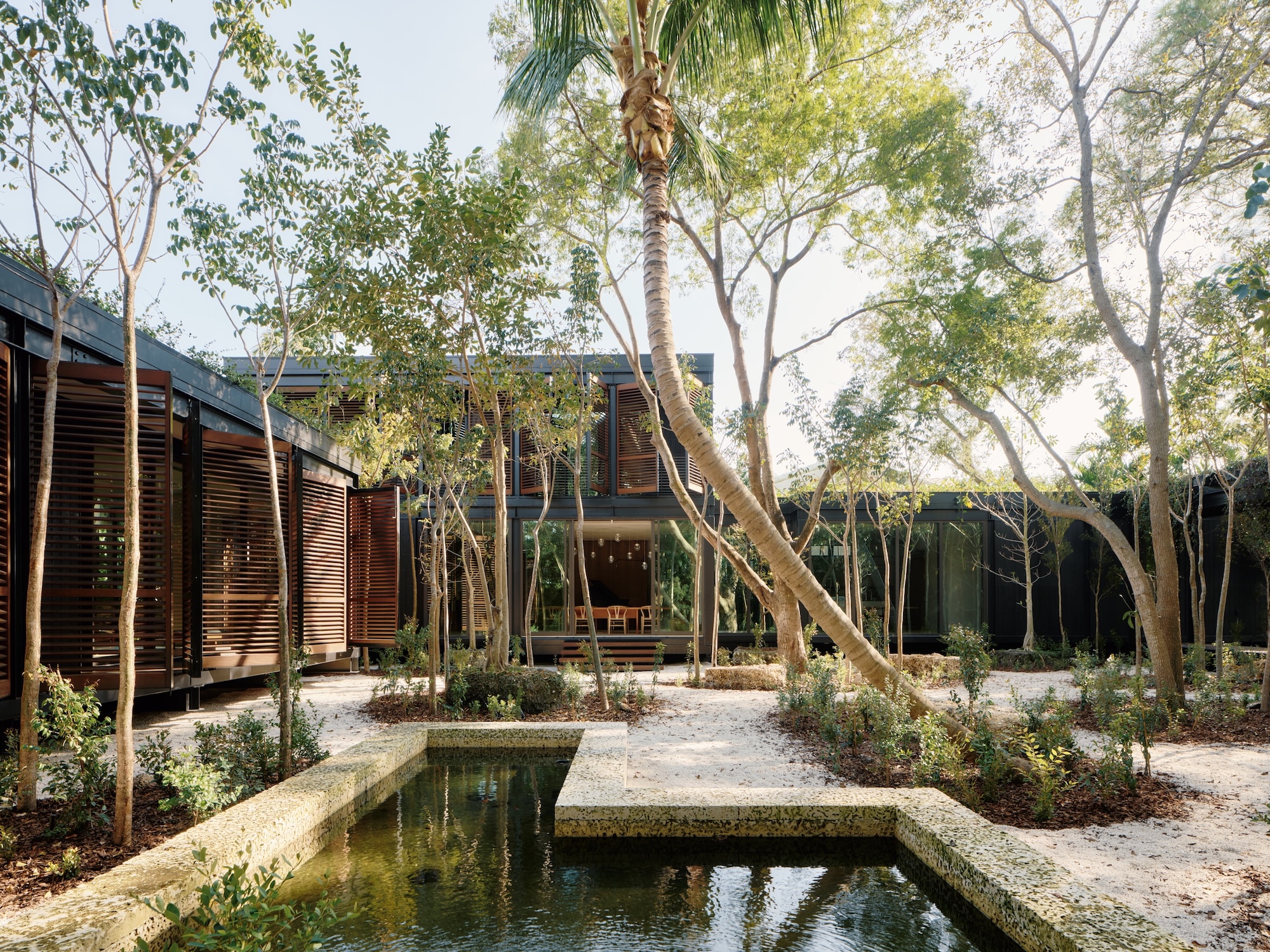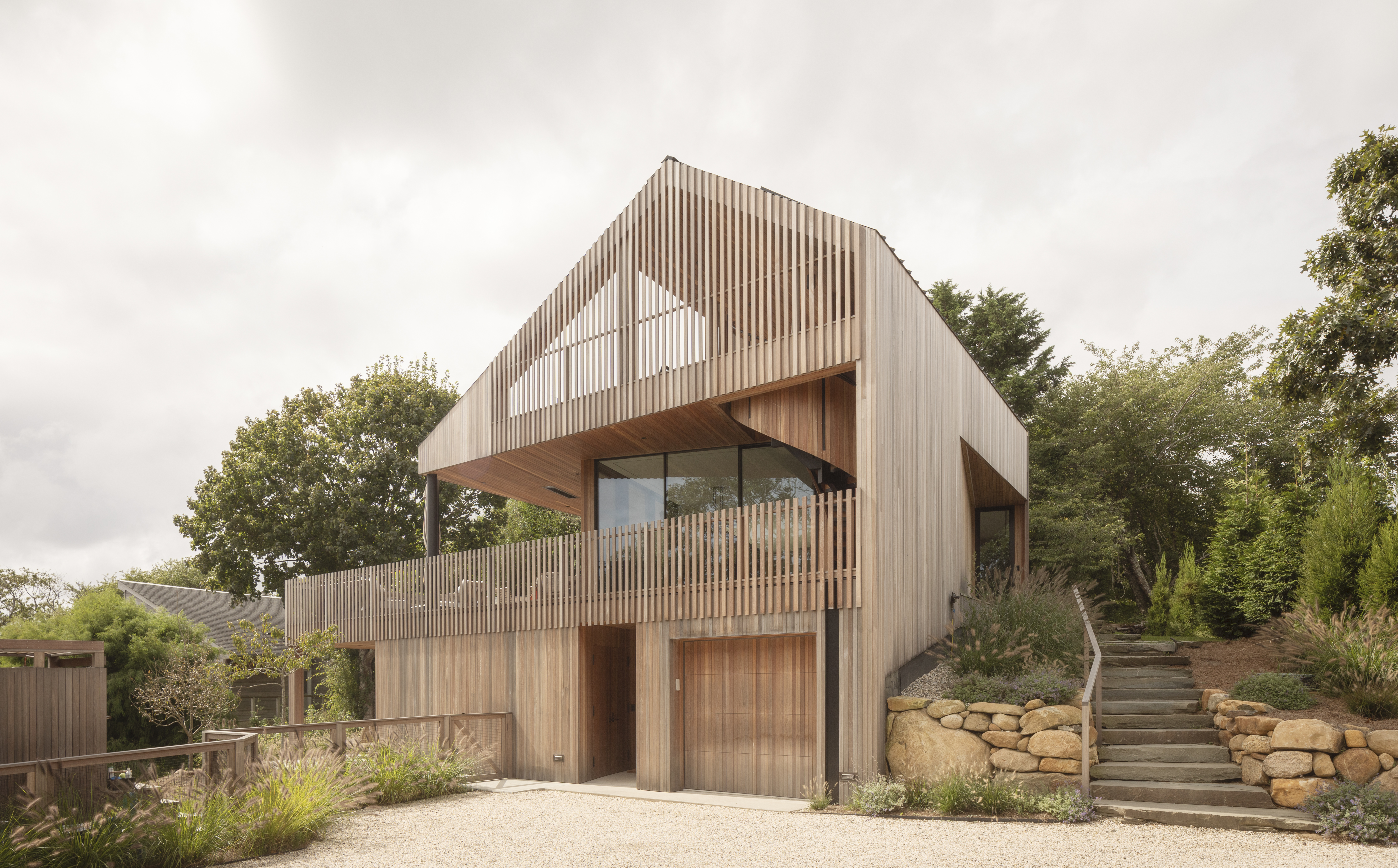Chicago upside-down house turns convention on its head
Chicago architects Kwong Von Glinow take a conventional pitched-roof house and open up the interior, transforming it into a dramatic, open plan space

James Florio - Photography
Ardmore House was designed and built for personal use by architects Alison Von Glinow and Lap Chi Kwong of Kwong Von Glinow. Making the most of an overlooked site – a small alleyway at the end of a residential avenue – the architects have pushed the built envelope to the edge of the plot and inverted the traditional house structure.
Despite the relatively conventional pitched-roof house approach, the upper floor houses the living space, with bedrooms on the middle floor and stores and utility on the ground floor. The striated façade mirrors the internal arrangement, with a long row of glazing on the upper level and a solid concrete base where the project meets the street. The wooden Accoya cladding comes in two shades, black and grey, further reducing the bulk of the overall volume.
The independently accessed basement level is zoned as a multi-functional space, incorporating storage space, room for an office or even a self-contained rental unit. The ground floor is dominated by a large inner courtyard, a gently curving volume that rises right up to the pitched roof and serves as both circulation space, lightwell and informal living space.

The three bedrooms are accessed from this space, with a primary suite overlooking the external courtyard to the north. Deep doorway recesses give strength and sculptural presence to this curved wall, with a ribbon of vertical balustrades above. The primary living space is on the uppermost floor, with the ceiling raised up into the pitched roof. This in turn is supported by four large wooden trusses, with create a monumental sense of scale and pair with the use of wood in the staircases, floors and fixed furnishings.
The ribbon windows form an unbroken 56 long run, creating a panoramic view of the surroundings and the sense of an indoor balcony. You’re never unaware of the house’s tight urban site, regardless of where you are within the space, but the architects have made the most of the location, unashamedly framing views of neighbouring buildings, balconies and even the brick flank wall of the adjacent structure.
Pared back detailing, a very straightforward material and colour palette and expansive open plan spaces, all contribute to create a calming yet involving urban space. Kwong Von Glinow made an appearance in our 2017 Architects’ Directory thanks to their focus on housing projects with a twist and designs that invert established design thinking.










INFORMATION
Receive our daily digest of inspiration, escapism and design stories from around the world direct to your inbox.
Jonathan Bell has written for Wallpaper* magazine since 1999, covering everything from architecture and transport design to books, tech and graphic design. He is now the magazine’s Transport and Technology Editor. Jonathan has written and edited 15 books, including Concept Car Design, 21st Century House, and The New Modern House. He is also the host of Wallpaper’s first podcast.
-
 'Design at its most ambitious': meet the 2025 Royal Designers for Industry
'Design at its most ambitious': meet the 2025 Royal Designers for IndustryThe Royal Society for Arts announces the five new Royal Designers for Industry as well as two Honorary Royal Designers for Industry
-
 A new art museum brings colour, quirk and a celebration of creativity to Doha
A new art museum brings colour, quirk and a celebration of creativity to DohaLawh Wa Qalam: M. F. Husain Museum is awash with colour and character, courtesy of Indian architect Martand Khosla and the Qatar Foundation
-
 Out of office: The Wallpaper* editors’ picks of the week
Out of office: The Wallpaper* editors’ picks of the weekThis week, the Wallpaper* team had its finger on the pulse of architecture, interiors and fashion – while also scooping the latest on the Radiohead reunion and London’s buzziest pizza
-
 The Stahl House – an icon of mid-century modernism – is for sale in Los Angeles
The Stahl House – an icon of mid-century modernism – is for sale in Los AngelesAfter 65 years in the hands of the same family, the home, also known as Case Study House #22, has been listed for $25 million
-
 Houston's Ismaili Centre is the most dazzling new building in America. Here's a look inside
Houston's Ismaili Centre is the most dazzling new building in America. Here's a look insideLondon-based architect Farshid Moussavi designed a new building open to all – and in the process, has created a gleaming new monument
-
 Frank Lloyd Wright’s Fountainhead will be opened to the public for the first time
Frank Lloyd Wright’s Fountainhead will be opened to the public for the first timeThe home, a defining example of the architect’s vision for American design, has been acquired by the Mississippi Museum of Art, which will open it to the public, giving visitors the chance to experience Frank Lloyd Wright’s genius firsthand
-
 Clad in terracotta, these new Williamsburg homes blend loft living and an organic feel
Clad in terracotta, these new Williamsburg homes blend loft living and an organic feelThe Williamsburg homes inside 103 Grand Street, designed by Brooklyn-based architects Of Possible, bring together elegant interiors and dramatic outdoor space in a slick, stacked volume
-
 This ethereal Miami residence sprouted out of a wild, jungle-like garden
This ethereal Miami residence sprouted out of a wild, jungle-like gardenA Miami couple tapped local firm Brillhart Architecture to design them a house that merged Florida vernacular, Paul Rudolph and 'too many plants to count’
-
 Tour Cano House, a Los Angeles home like no other, full of colour and quirk
Tour Cano House, a Los Angeles home like no other, full of colour and quirkCano House is a case study for tranquil city living, cantilevering cleverly over a steep site in LA’s Mount Washington and fusing California modernism with contemporary flair
-
 An ocean-facing Montauk house is 'a coming-of-age, a celebration, a lair'
An ocean-facing Montauk house is 'a coming-of-age, a celebration, a lair'A Montauk house on Hither Hills, designed by Hampton architects Oza Sabbeth, is wrapped in timber and connects its residents with the ocean
-
 With a freshly expanded arts centre at Dartmouth College, Snøhetta brings levity to the Ivy League
With a freshly expanded arts centre at Dartmouth College, Snøhetta brings levity to the Ivy LeagueThe revamped Hopkins Center for the Arts – a prototype for the Met Opera house in New York –has unveiled its gleaming new update